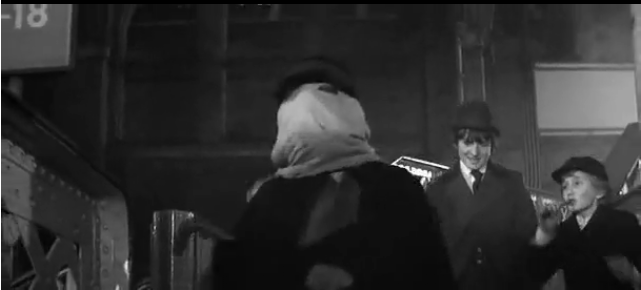
THE ELEPHANT MAN (1980, Lynch)
Today’s shot is from the most famous scene of David Lynch’s horrifying and heartbreaking Oscar-nominated film The Elephant Man and it demonstrates what I love about a really calculated and restrained use of the Close Up. It’s often said that holding off on the use of a Close-Up until just the right moment can really magnify the emotional impact of a moment, and this really proves it.
In this harrowing scene, John Hurt‘s character John Merrick, aka the Elephant Man, is trying to make it out of the train station without notice, but a pesky kid foils his escape, and soon a mob is on his heels, as is the shock of pure panic.
David Lynch’s use of Sound and a Close Up
The sound design is such an important part of this climate of terror; David Lynch and Alan Splet (both credited for the film’s sound design) really take full advantage of a train station’s soundscape to ratchet up the anxiety. Note how the sounds of the trains and a screaming whistle start to really become unhinged just as we finally cut to a CU of that bag that conceals poor Merrick’s head.
Holding off on that CU until this instant of sheer panic really brings into sharp focus the moment of realization that Merrick is suddenly in deep shit, and he knows it (like those poor saps in Deliverance, minus the close-up, though).
This sequence culminates with his being cornered in the restroom by an irate mob which prompts his immortal line about not being an animal and his collapse into a heap next to the urinal, a powerful visual that somehow doesn’t feel too on the nose to me even though, well, he collapses next to a urinal after saying he’s a human being.
Why do you think that last shot of the urinal works or doesn’t work? It reminds me of Martin Sheen in the hotel freak out scene in Apocalypse Now, somehow it works, even though Coppola’s treading an extremely thin line between the dramatic and the overwrought. I think Lynch treads that line successfully here, too.
Here’s the moment of the expertly used close-up at 4:20 but I recommend starting with the top of the sequence at 3:10.
johnef
I forgot how crazy scary and emotional that moment is…the texture of the sequence is so complex and effective. Thanks for sharing.
Pingback: THE GODFATHER (1972, Coppola) « shot4shot